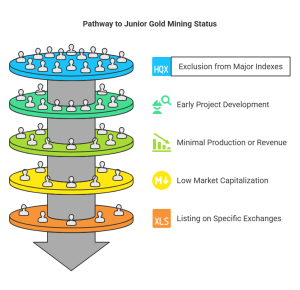On This Page
Table of Contents
A junior gold miner is typically an early-stage gold exploration company engaged in the discovery and preliminary development of gold deposits. Unlike major mining firms that own producing mines and generate consistent revenue, junior mining companies primarily focus on exploring new sites and verifying the existence of economically viable gold resources. These firms often operate with smaller teams and budgets, making them akin to startups in the mining in
Core Characteristics:
- Primarily engaged in exploration or development, not production.
- Often possess mineral rights or leases on undeveloped sites.
- May be in the feasibility stage—trying to prove whether a site is economically viable.
- Operate with smaller teams, often led by geologists and mining engineers.
- Typically listed on smaller exchanges, like the TSXV.
They’re the startup scene of the mining world—high risk, high reward, and driven by discovery. When one of these early-stage gold companies hits a major gold deposit, it can turn into a massive opportunity for investors.
Structural Criteria for Classification as Junior Gold Mining Company

There’s no one-size-fits-all definition, but certain structural elements help classify them:
- Excluded from indexes like the HUI and XAU, which track larger, established miners.
- Projects are in the exploration or early development phase.
- Lack of significant production or revenue—this is crucial.
- Low market capitalization (more on that below).
- Mostly listed on exploration-friendly exchanges like the TSX Venture Exchange (TSXV).
These companies usually haven’t crossed the development threshold that would move them into mid-tier or producer territory. Their assets are still mostly tied up in resource discovery, which means their value is speculative and driven by exploration success.
The Role of Market Capitalization in Defining Juniors
A big part of the “junior” label comes down to market cap. Most junior gold miners fall into the $1 million to $5 million range, though some may creep higher. In market terms, they’re considered micro-cap or small-cap companies.
Why does this matter?
- Low market cap = high volatility.
- They’re more sensitive to investor sentiment, gold prices, and funding news.
- Typically attract retail investors and speculative capital.
They’re often listed on the TSXV, where smaller companies can more easily raise funds through equity offerings, albeit with frequent dilution.
Where Junior Miners Are Listed (Exchange Indicators)
One major clue that you’re dealing with a junior? Where they trade.
Junior miners are rarely listed on major exchanges like the NYSE or full TSX. Instead, look for:
- TSX Venture Exchange (TSXV) – the home base for many early-stage miners.
- OTC Markets (like OTCQB) – a U.S. alternative for international juniors.
- ASX (Australian Stock Exchange) – another hotbed for mining startups.
These exchanges cater to exploration-stage companies, with more relaxed listing requirements and better access to venture capital.
Financing Models and Dependency on Venture Capital
Here’s the deal—junior gold miners don’t make money the usual way. Since they’re not producing gold, they can’t sell it to fund operations. So, how do they survive?
They rely heavily on:
- Venture capital and private placements
- Equity financing through frequent stock offerings
- IPO funds for early capital injection
Don’t expect dividends—any money raised is reinvested into exploration. This means there’s a high capital burn rate and a constant need for new funding rounds. It’s a bit like being on a financial treadmill.
Operational vs Exploratory Status (Production vs Prospecting)
A major distinction in the gold space is exploration vs production.
Junior gold companies are squarely in the exploration phase. Their work involves:
- Geological surveys
- Drilling programs
- Land acquisitions
- Feasibility and permitting
They don’t operate producing mines. If they’re successful, they’ll either move toward development or get acquired by larger mining firms. Until then, they remain in the pre-production stage.
Ambiguity & Debate in the Term “Junior Miner”
Here’s where it gets a bit murky. Not everyone agrees on what a junior gold miner is.
There’s no universally accepted definition, and that leads to confusion. Some mid-tier producers still get lumped into the “junior” category by analysts or media. Others blur the line by operating multiple exploration and development-stage projects.
This gray area causes:
- Analyst disagreements
- Investor misunderstandings
- Misclassification of mining firms
So, always check a company’s current operational status before investing.
Risk Factors Specific to Junior Gold Miners
Junior miners are exciting, but man, are they risky.
Here’s why:
- Higher burn rate and dependency on constant funding.
- Highly sensitive to gold price fluctuations.
- Many never make it to production—bankruptcy is common.
- Long delays between discovery and monetization.
If gold prices drop, exploration budgets get slashed, and juniors often take the hardest hit. That said, when gold rallies? These stocks can skyrocket.
Sample Junior Gold Mining Stocks (Real-World Companies)
Here are some junior gold miners currently listed on the TSXV:
- Adyton Resources (TSXV: ADY) – focused on PNG-based gold exploration.
- Montage Gold (TSXV: MAU) – West African gold explorer with multiple projects.
- Zodiac Gold (TSXV: ZOD) – operates in underexplored regions in Africa.
These companies are in different phases of exploration and may release updates on drill results, resource estimates, or strategic partnerships—which can cause wild price swings.
Want to track them? Tools like Junior Mining Network can help.
Investing Through ETFs (Indirect Exposure to Juniors)
Not ready to pick individual junior miners? ETFs offer a way to spread the risk.
Top Junior Mining ETFs:
- VanEck Junior Gold Miners ETF (GDXJ) – diversified exposure to global juniors.
- Sprott Junior Gold Miners ETF (SGDJ) – includes quality small-cap names.
- Direxion Daily Junior Gold Miners Bull 2X ETF (JNUG) – leveraged ETF for short-term bullish bets.
These funds provide:
- Built-in diversification
- Exposure to the junior gold cycle
Less individual risk vs. picking one stock
Tools and Resources for Evaluating Junior Miners
Evaluating juniors takes a bit of digging (pun intended). Here are some go-to tools:
- Junior Mining Network – daily updates and news alerts
- Drill Result Calculators – to interpret assay data
- Mining Screeners – like those on Yahoo Finance or TMX Money
- Company Reports – investor presentations and feasibility studies
- Exploration Newsletters – curated insights from geologists and analysts
Looking for red flags? Watch for management changes, lack of drill progress, and over-reliance on dilution.
Final Thoughts for Investors
So, should you invest in junior gold miners?
If you’ve got a strong risk tolerance, a passion for speculative plays, and patience for long timelines, juniors can be exciting. They’ve got serious upside—especially in a bull gold market—but they’re not for the faint-hearted.
Tips for New Investors:
- Diversify across a few names or use ETFs.
- Watch for strong management teams and credible drill results.
- Be ready for volatility and long holding periods.
- Consider juniors as a small part of a larger gold investing strategy.
Read more about : Physical Gold vs. Gold Funds



